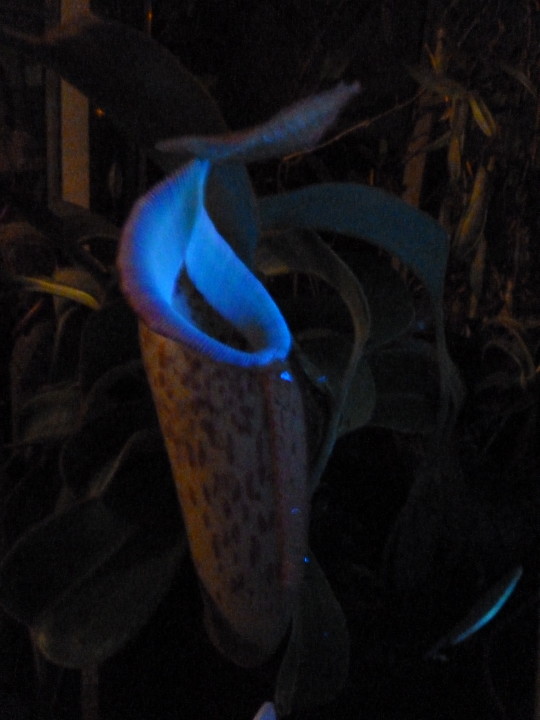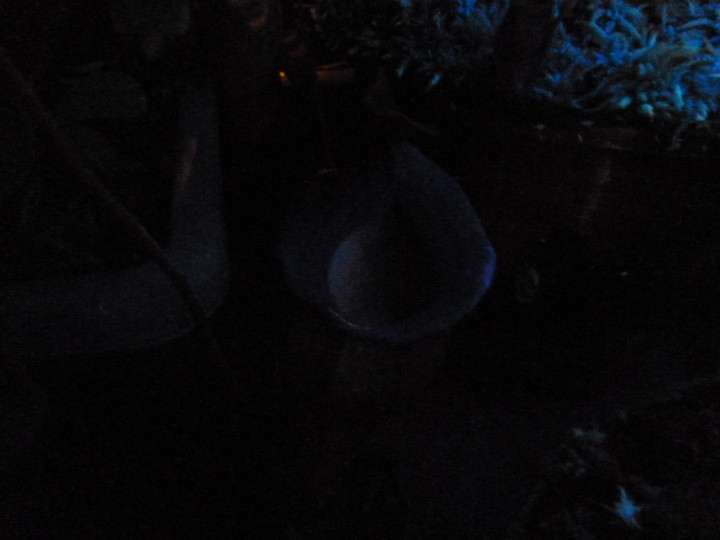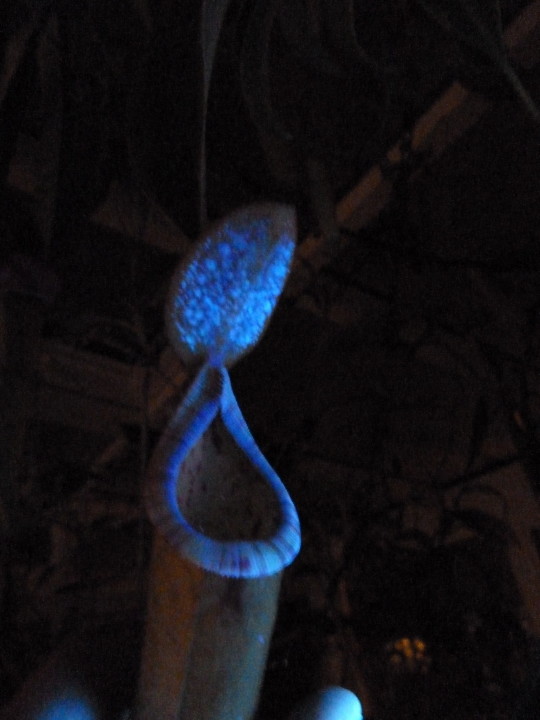|
|
Post by shartmeyer on Mar 4, 2013 10:38:48 GMT
Together with our friend Richard Bayerl (hobby mineralogist) we could verify the article "Carnivorous plant species glow blue to lure prey" (Remark: by fluorescence when illuminated with UV-light). When using 254 & 366 nm wavelength the peristome and lower side of the lid as well as nectaries glow bluish. A diode-lamp with black light (390 nm) did not work well, as we checked even one year ago, therefore we were of course doubtfully. We will write a short article on our results on numerous different species, therefore we show only two photos at the moment. More will follow after publication, probably in May. We could actually confirm N. khasiana to fluorescence, but no Drosera did that, except the dense hairs of D. ordensis (and probably other members of section Lasiocephala will do that too). The photos below show a positive result for our (crossed at our greenhouse) N. talangensis x truncata and a negative result for N. jacqueliniae. However, this phenomenon does not necessarily mean that the fluorescence is responsible for a better trapping success, but the sugar of the nectaries, which is obviously produced together with a flurorescent compound. Soon more ...   |
|
|
|
Post by shartmeyer on Mar 5, 2013 10:11:15 GMT
Meanwhile many different forum threads world-wide show pictures of blue shining CP-traps, which are made with a usual blacklight torch (approx. 390 nm). Some of the photos are looking nicely, however, not all but most of them show only reflexion of blue visible light, which is also emitted by these "money testers" but that is no fluorescence.
UV/VIS-spectroscopy was a part of my job as a laboratory director in an analytical department at Sandoz Switzerland (now Clariant), where I managed also the quality control for e.g. the (bluish fluorescent) optical brighteners "Leucophor" (for the paper and textile industry), therefore I know what I'm talking about. Here is a grading for your information:
Visible light: 380 - 780 nm
(Near UV) UV-A: 380–315 nm
(Middle UV) UV-B: 315–280 nm
(Far UV) UV-C-FUV: 280–200 nm
(Vacuum UV) UV-C-VUV: 200–100 nm
(Extreme UV) EUV: 121–10 nm
|
|
|
|
Post by shartmeyer on Mar 8, 2013 12:51:29 GMT
And here is the source of the fluorescence: The sugar produced by the nectaries on the lower side of the lid. The photo shows clearly that the nectar contains the fluoresce compound. There is no doubt that those traps which have a layer of sugar are more attractive for insects than traps which have been cleaned with a solvent. The fluorescence of the nectar covered parts of the trap is a fact, but the luminescence is only visible in the dark using a UV-lamp, moon light does not contain enough UV. To assert such a low glowing, which is on top of that invisible under daylight, to be the reason for a better prey-capture is actually very airy. And I wonder, why the clearly visible relation between nectar and trap-fluorescence has not been considered.  |
|
coline
Full Member
Life's essence: patience
Posts: 484 
|
Post by coline on Mar 8, 2013 14:01:23 GMT
So then, what do you think could be the purpose of the plant by producing such compounds in the nectar?
|
|
|
|
Post by shartmeyer on Mar 10, 2013 11:13:54 GMT
For what reason do you think that your fingernails do fluoresce like a peristome under UV-light, if not to attract insects?
Please consider that fluorescence is a very common and wide spread phenomenon in nature. Many compounds like poly cyclical aromatic hydrocarbons fluoresce, but most important are their pharmacological effects, their luminescence is just an outgrowth. And that is exactly the point where I criticize the article. The important questions should be: what kind of compound inside the Nepenthes nectar is responsible for the fluorescence and does it have a pharmacological impact on insects that drink the nectar. Only this way will lead to a serious answer to your above question. Is it (very likely) a compound related to that in Sarracenia nectar? That Coniin called compound shows a very nice bluish fluorescence (as clearly mentioned in chemically but not CP-related publications) but has also a real deafening effect to insects. For that reason also Sarracenia is fluoresce. Unfortunately I am retired and do not have the technical capabilities to check that with appropriate analytical equipment.
However, maybe some persons who read this forum take the chance to search for that compound(s), the analytical methods to realize that are not very challenging for a modern laboratory.
Last but not least the answer to my question above: Blood is also a strong fluoresce compound. For that reason Bones (TV-series) is always looking for blood with a black light torch. Under UV-light the epidermis of your skin is blocking the luminescence, but your fingernails are more or less translucent. Therefore they show a slight bluish fluorescence under UV-lamps and (invisible due to outshining) with sunlight. I don't know any person who reported the attraction of insects by its fingernails.
|
|
coline
Full Member
Life's essence: patience
Posts: 484 
|
Post by coline on Mar 10, 2013 15:13:49 GMT
I see, indeed that deeper meaning of the fluid, as it could be a lure for the insects that could create dizziness or some other effect for them to fall in. Once analized in the nepenthes (which we know have the compound) it could be much easier to check if other plants produce it. As a student I'm not able at the moment to test the fluid, but in a future indeed it could be a good research proyect with some chemistry colleagues to get into.
|
|
|
|
Post by shartmeyer on Mar 11, 2013 10:20:49 GMT
Yes, Coniin is the famous poison of the Poison Hemlock (Conium maculatum), present also in other genera. Typical symptoms for an intoxication: vision disorders and paralysis starting in the legs. This sounds like a perfect designer-drug for pitfall-traps.
I am working on a publication for a German journal, but I could not find literature about Coniin in Nepenthes, only in Sarracenia. Do you know any literature that confirms the presence of Coniin also in Nepenthes , or is that still not published?
|
|
coline
Full Member
Life's essence: patience
Posts: 484 
|
Post by coline on Mar 11, 2013 22:55:58 GMT
At the moment I do not know any, but maybe, in the NCBI, if you compare the gene that codes for Coniin in sarracenia with the blasting tool, there might appear the same or similar gene or protein in nepenthes. Just a supposition because I have not found about it yet.
|
|







